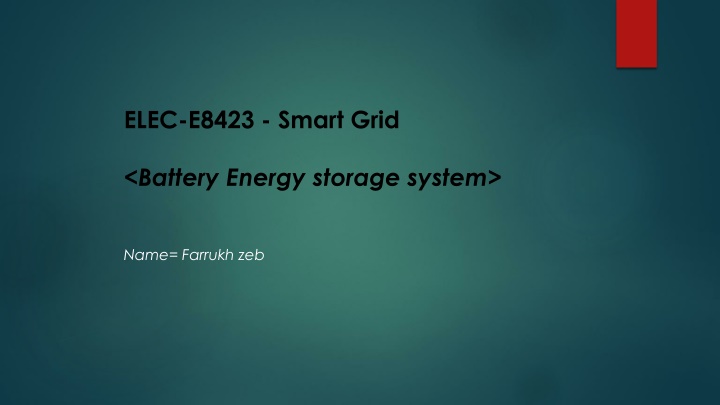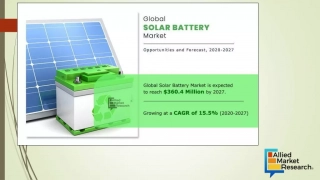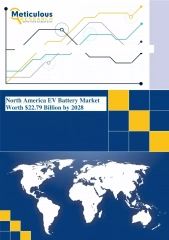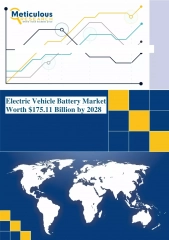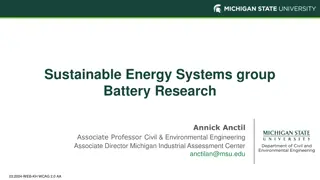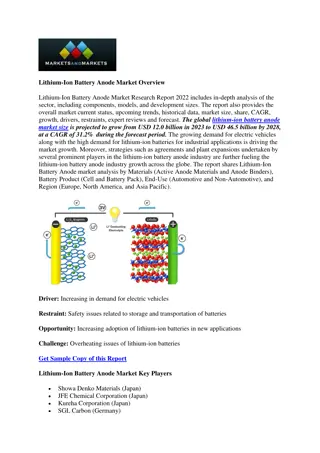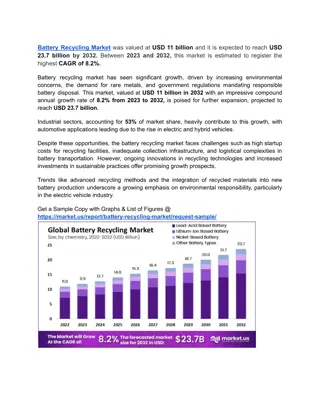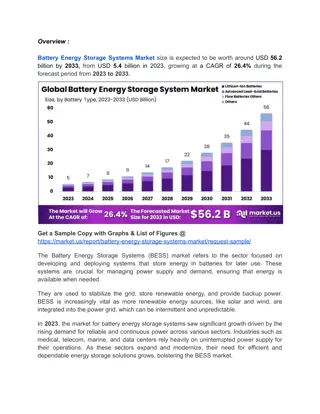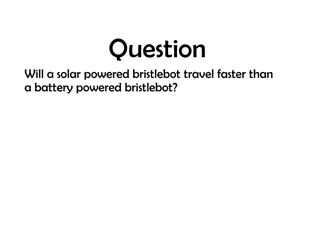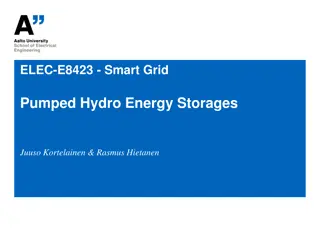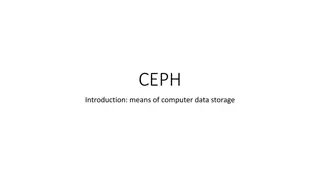Battery Energy Storage and Sustainability
Batteries are crucial for storing electricity from renewable sources, but their reliance on rare materials raises sustainability concerns. Super capacitors offer a more environmentally friendly alternative, utilizing abundant and non-toxic materials. Advancements in energy efficiency are helping mitigate battery's environmental impact, but super capacitors currently hold a sustainability edge due to their composition.
Download Presentation

Please find below an Image/Link to download the presentation.
The content on the website is provided AS IS for your information and personal use only. It may not be sold, licensed, or shared on other websites without obtaining consent from the author.If you encounter any issues during the download, it is possible that the publisher has removed the file from their server.
You are allowed to download the files provided on this website for personal or commercial use, subject to the condition that they are used lawfully. All files are the property of their respective owners.
The content on the website is provided AS IS for your information and personal use only. It may not be sold, licensed, or shared on other websites without obtaining consent from the author.
E N D
Presentation Transcript
ELEC-E8423 - Smart Grid <Battery Energy storage system> Name= Farrukh zeb
Battery Energy storage System Why batteries? Why Battery energy storage services? What is its impact on modern technologies? Now a days trend?
Battery Management system PORTABLE POWER & ENERGY STORAGE: 1. Batteries provide portable power for devices from smartphones to electric vehicles. o They enable energy storage from renewable sources, ensuring grid stability and uninterrupted power supply. o CRITICAL ROLE IN SAFETY & EFFICIENCY: 2. Battery Management Systems (BMS) monitor and manage parameters like voltage and temperature, ensuring safe and efficient battery operation. o BMS prevent hazards like overcharging and overheating, crucial for safety in various applications. o DRIVING INNOVATION & SUSTAINABILITY: 3. Batteries power electric vehicles, reducing reliance on fossil fuels and mitigating environmental impact. o Advances in battery technology and BMS optimize performance, driving innovation towards sustainable energy solutions. o
Batteries vs supercapacitors Storage batteries play a crucial role in storing electricity generated from intermittent sources such as wind and solar power. They are essential for providing backup power for actuators in wind turbine systems and aiding in load balancing during periods of peak demand. Supercapacitors serve as backup power sources for swiftly controlling blade pitch in the event of failures. They also act as stabilizers for mitigating voltage fluctuations in photovoltaic and wind energy systems, while supporting microgrid storage to address intermittency and fluctuating demand.
Sustainability and Environmental Impact Batteries pose sustainability concerns due to their reliance on rare and potentially harmful materials such as lithium, cobalt, and nickel. Moreover, the mining and refining processes for these materials can cause environmental damage and raise ethical issues. At the end of their lifespan, batteries degrade and release chemicals into landfills, contaminating soil and water, which in turn harms ecosystems. On the other hand, supercapacitors utilize more sustainable electrode materials like activated carbon sourced from renewable biomass. Their straightforward material composition also facilitates easier recycling compared to batteries. While advancements in energy efficiency technology are mitigating the environmental impacts of battery usage in certain applications, supercapacitors currently hold a sustainability edge over batteries for energy storage. This is attributed to their use of abundant and non-toxic materials, rendering them simpler to produce, reuse, and responsibly dispose of.
Property Supercapacitors Batteries Cyclability (cycle life) >100,000 <1000 Specific energy Moderate (<10 Whkg-1) High (30-150 Whkg-1 ) Very high (2 kWkg-1 ) at 95 % efficiency, low impedance Moderate (0.5 kWkg -1 ) Specific power Discharge efficiency Fast and most efficient for discharge from V to V/2 Slow and efficiency depends on internal resistance Electrochemical reactions Little activation polarization Significant activation polarization Storage mechanism Physical Chemical Power limitation Separator, ionic conductivity Reaction kinetics and mass transport Electrode surface area Electrode mass Energy limitation Very high same as discharge rate Reaction kinetics mass transport Charge rate Cycle life limitation Sometimes side reactions Physical stability, chemical reversibility Shelf life Very long Low
???? DC-DC converter Battery Inverter ?? ?? ???? MPC Super capacitor DC-DC converter
Solid state Batteries Solid-state batteries offer a higher energy density compared to traditional lithium-ion counterparts, enabling them to store more energy within the same volume. This advancement can result in electric vehicles and smartphones with longer range, capable of lasting for days on a single charge, as well as smaller and lighter batteries for portable devices. Moreover, solid-state batteries boast faster charging capabilities than liquid-electrolyte batteries, making them particularly well-suited for applications like electric vehicles, where rapid charging is essential. Say goodbye to long hours of waiting to hit the road again! In addition to their superior energy density and charging speed, solid-state batteries are also safer. Their reduced risk of catching fire or exploding compared to liquid batteries makes them an ideal choice for safety-critical applications such as electric vehicles and drones.
References https://www.sciencedirect.com/science/article/pii/S259000722300059X https://www.dw.com/en/what-you-need-to-know-about-solid-state-batteries/a-66695582 S. Liu, J. Peng, L. Li, X. Gong and H. Lu, "A MPC based energy management strategy for battery-supercapacitor combined energy storage system of HEV," 2016 35th Chinese Control Conference (CCC), Chengdu, China, 2016, pp. 8727-8731, doi: 10.1109/ChiCC.2016.7554751. https://www.fomtechnologies.com/insights-blog/energy-storage-technologies- supercapacitors
